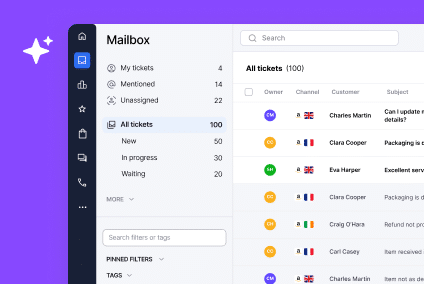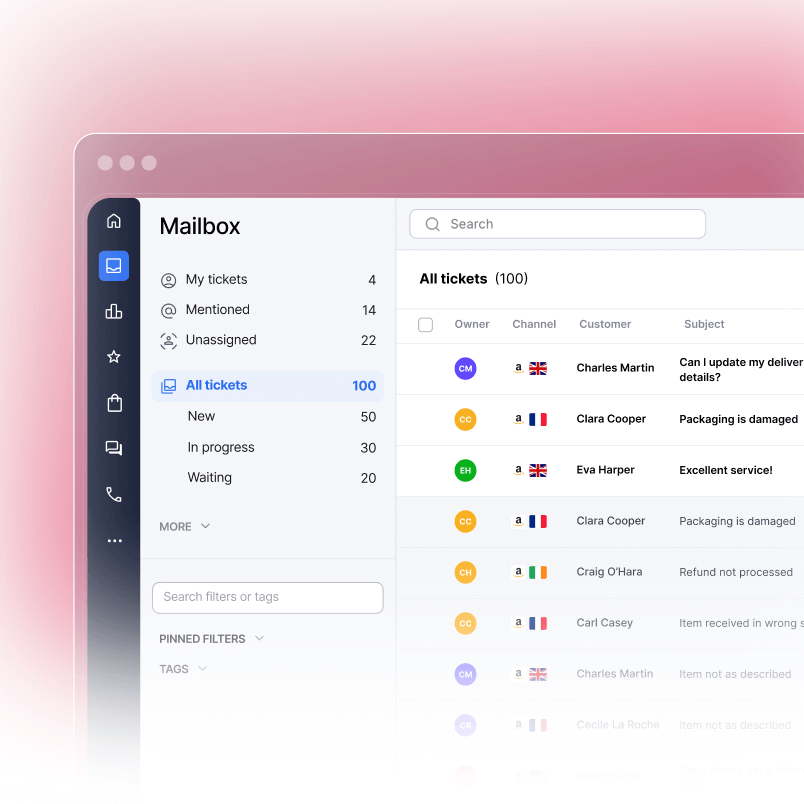Your Amazon seller feedback rating controls whether customers see your products, whether you win the Buy Box, and ultimately whether your business grows or stalls. A single negative review can damage your reputation, but managing feedback manually across hundreds or thousands of orders is unsustainable. That’s why we’re showing you how to automate your feedback strategy so your reputation builds itself.
This guide covers why seller feedback matters, what triggers negative reviews, and the automation workflows that successful sellers use to maintain strong ratings without constant manual work.
Why Amazon Seller Feedback Matters for Your Business
Why Amazon Seller Feedback Matters for Your Business
Your feedback score directly affects your bottom line. Amazon uses seller feedback to determine Buy Box eligibility, search visibility, and customer trust. When your feedback rating drops below 4.0 stars, you risk suspension or restricted selling privileges.
Third-party sellers in competitive categories face intense pressure to maintain high ratings. A competitor with a 4.8-star rating will outrank you consistently, even if your products are identical. Customers filter by rating before they click on your listing.
The feedback system on Amazon operates separately from product reviews. Seller feedback rates your service as a merchant: Did you ship on time? Was packaging acceptable? Did you communicate clearly? Product reviews rate the actual item. You can’t remove negative product reviews, but you can manage seller feedback through removal requests and prevention strategies.
Feedback removal is possible under specific Amazon policies. If a customer leaves feedback that violates guidelines, you can request Amazon remove it. This is where automation helps: tools monitor incoming feedback and flag removable comments instantly.
Recently, Amazon changed how feedback works. As of August 2025, customers can now leave star-only ratings without written comments. This means feedback will arrive with less context, making it harder to identify removal-eligible messages. Automation tools that flag keywords become even more valuable.
Common Reasons Sellers Get Negative Feedback
Most negative feedback falls into predictable categories. Understanding these patterns lets you prevent them before they happen.
Late shipments
Late shipments are the top driver of negative feedback. A delay of even one day after your stated handling time triggers complaints. Prime customers expect two-day delivery and become frustrated with any deviation.
Poor packaging
Poor packaging causes feedback when items arrive damaged, dented, or with missing components. Customers blame the seller first, even when the courier damages the package. Using appropriate box sizes, padding, and protective materials prevents these issues.
Miscommunication and silence
Miscommunication and silence damage your reputation. When customers reach out with questions before purchase, they expect responses within 24 hours. Sellers who don’t reply to messages get negative feedback.
Fulfillment errors
Fulfillment errors, wrong item shipments, and incomplete orders generate immediate negative feedback. A customer orders two units and receives one. A wrong color gets sent. These mistakes stick with your rating for months.
Prime vs FBM gaps
The gap between Prime and Fulfillment by Merchant experiences also drives complaints. When FBM shipping takes 10 days versus Prime’s 2-day promise, customer expectations clash with reality.
How Amazon Calculates Your Seller Feedback Score
Amazon rates feedback on a 1 to 5-star scale. One star is „Poor“ and five stars is „Excellent.“ Your overall rating is the average of all feedback received over time.
Recent feedback carries more weight in Amazon’s calculations. Feedback from the last 30 days influences your score more than feedback from 90 days ago. This means one recent issue can temporarily drop your rating significantly, but improving your service quickly recovers it.
Amazon also monitors your Order Defect Rate, which includes negative feedback, chargebacks, and A-to-Z guarantees. Sellers are required to maintain an ODR below 1%. If your ODR climbs above this threshold, you risk warnings and suspension.
Feedback removal is Amazon’s built-in pressure valve. If feedback violates Amazon’s feedback policy, you request removal. Common removal reasons include mentions of issues already resolved, feedback containing threats, and feedback that mentions price or discount codes. Sellers who systematically request removal for qualified feedback keep their ratings clean.
Data on feedback submission is critical to understand. Less than 1% of buyers leave seller feedback, so most transactions generate no rating at all. This means the feedback you do receive carries significant weight. Additionally, in 2020, 92% of feedback was positive; five years later, that share dropped to 84%. The shift reflects rising customer expectations and stricter feedback standards.
5 Automated Strategies to Improve Your Feedback
Proactive messaging
Proactive messaging reaches customers before negative feedback happens. Send a friendly message two days after delivery asking if the customer received their order and if everything is satisfactory. Include a link to contact you if issues arise.
Timing is critical. Messages sent immediately after delivery feel salesy. Messages sent after four days are often ignored. Two to three days after delivery is the sweet spot.
Tone matters more than length. Keep the message brief, helpful, and conversational. Avoid phrases that sound like you’re begging for five-star ratings. Amazon’s TOS prohibits direct requests for positive feedback.
Feedback request tools
Feedback request tools bypass manual message sending. 55% of Amazon sellers use the Amazon Request a Review message to ask for feedback. The button appears in customer accounts and emails automatically. This method is 100% compliant with Amazon policy.
Third-party platforms like JungleScout, FeedbackWhiz, and Helium 10 automate follow-up workflows. You set up a sequence: first message on day two, second message on day four if no feedback received, third message on day seven. The tool sends everything automatically.
Automated escalation for negative feedback
Automated escalation catches negative feedback before it becomes a bigger problem. Set up keyword alerts for phrases like „damaged,“ „late,“ „wrong item,“ or „haven’t received.“ When these keywords appear in incoming feedback, a ticket creates automatically in your support system.
Route the ticket to your support team immediately. They get a templated response ready to go. The faster you respond to negative feedback, the more likely the customer lets you fix the problem.
Feedback suppression and removal automation
Feedback suppression and removal automation flags messages that qualify for Amazon removal. Instead of reviewing feedback manually, the tool identifies removal-eligible comments and queues them for a one-click removal request.
This saves hours of manual work. A seller with 10,000 monthly orders might receive 200 pieces of feedback. Scanning each one for removal eligibility takes time. Automation reduces that work to a quick review of the tool’s flagged items.
Best Tools for Automating Feedback Management
JungleScout
JungleScout’s Feedback Manager monitors all incoming feedback in real-time. You get daily digests, keyword alerts, and removal recommendations. Templates for common response scenarios cut response time from 30 minutes to three minutes.
FeedbackWhiz
FeedbackWhiz specializes in feedback automation. It handles email follow-ups, negative feedback alerts, and removal requests. The tool integrates directly with Seller Central, so you don’t juggle multiple logins.
Helium 10
Helium 10’s Dashboard includes a feedback tool that tracks trends over time. You see which products generate the most negative feedback and identify systemic issues. Their automation handles message templates and follow-up sequences.
eDesk
eDesk offers a unified inbox for all Amazon messages, feedback, and questions. Automation routes messages by keyword, priority, and category. Your team always knows which feedback needs immediate attention.
Tool Comparison
| Tool | Core Feature | Pricing | Amazon TOS Compliant |
| JungleScout | Real-time feedback monitoring and removal recommendations | $29-$99 per month | Yes |
| FeedbackWhiz | Automated email sequences and negative feedback alerts | $30-$150 per month | Yes |
| Helium 10 | Dashboard analytics and feedback trend analysis | $99-$349 per month | Yes |
| eDesk | Unified messaging with routing automation | Custom pricing based on message volume | Yes |
Staying Compliant With Amazon’s Feedback Rules
Direct requests for ratings violate policy
Amazon’s TOS prohibits direct requests for five-star feedback. Phrases like „Please leave positive feedback“ or „We’d appreciate five stars“ violate policy. Your account risks suspension if you’re caught.
The „Request a Review“ button in Seller Central is your safest tool. It complies with Amazon’s guidelines because the request is generic and customer-initiated.
Incentives are forbidden
Amazon strictly prohibits paying for or offering an incentive (such as coupons or free products) in exchange for providing or removing feedback or reviews. This includes refunds offered after customers leave positive reviews.
Avoid black-hat tactics
Avoid black-hat tactics. Some sellers use fake customer accounts to leave positive feedback or ask relatives to leave good reviews. Amazon detects these patterns and permanently suspends accounts.
Best practices for feedback management
Do use neutral request templates. Ask for feedback without incentivizing a specific rating. Keep messages helpful and genuinely interested in customer satisfaction.
Respond to negative feedback professionally. Never argue, blame the customer, or make excuses. Acknowledge the issue, explain what you’re fixing, and offer a refund or replacement. This demonstrates accountability.
Final Takeaway
Improving your Amazon seller feedback requires consistency, speed, and the right systems. Automation handles the repetitive work: sending follow-ups, flagging removal-eligible feedback, and alerting your team to issues. The result is higher ratings without more hours invested.
Start with one automation: either proactive messaging or feedback request sequences. After two weeks, add keyword alerts for negative feedback. After a month, layer in removal automation. This phased approach lets you troubleshoot each system before scaling.
Your feedback rating is your reputation. Treat it with the urgency it deserves.
FAQs
What’s the difference between Amazon seller feedback and product reviews?
Seller feedback rates your service as a merchant, including shipping speed, packaging, and communication. Product reviews rate the quality of the item itself. Amazon will often remove feedback exclusively about the product rather than the seller. You control seller feedback through removal policies and prevention strategies. Product reviews are permanent and can’t be removed.
Can you remove negative Amazon seller feedback?
Yes, but only if it meets Amazon’s removal criteria. Feedback qualifies for removal if it mentions issues you’ve already resolved, contains inappropriate or offensive language, includes references to price or discounts, or discusses delivery carrier performance. Submit removal requests through Seller Central. Automation tools flag eligible feedback for you.
What’s considered a good Amazon seller feedback score?
A 4.5-star rating or higher is considered good. Scores above 4.7 stars are excellent. Scores below 4.0 stars trigger Amazon warnings and risk Buy Box suspension. Most successful sellers maintain ratings between 4.6 and 4.9 stars.
Which automation tools are best for Amazon feedback requests?
FeedbackWhiz, JungleScout, and Helium 10 are the most popular options. Each offers different features. FeedbackWhiz excels at email sequences. JungleScout specializes in real-time monitoring. Helium 10 provides analytics. Test each tool during a free trial to find the best fit.
How soon after delivery should I send a feedback request?
Send your first message two to three days after delivery. This timing avoids appearing salesy while the customer still has a fresh impression of your service. If no feedback appears by day seven, send a second gentle reminder.
What happens if I violate Amazon’s feedback communication rules?
First-time violations result in account warnings. Repeated violations risk suspension. Repeated patterns of black-hat feedback manipulation can result in permanent account closure. Stick to Amazon-approved communication methods and neutral request formats.
How does automation reduce my order defect rate?
Proactive messaging prevents complaints before they happen. When you reach out within two days asking if everything is okay, customers with issues contact you directly. Your Order Defect Rate impacts your ability to win the Buy Box. You resolve problems without negative feedback being left. This direct channel keeps defects low and protects your Buy Box eligibility.




